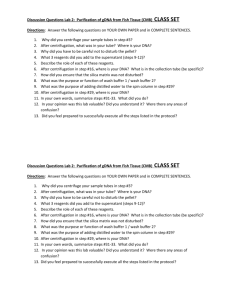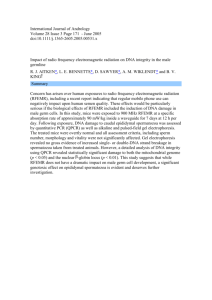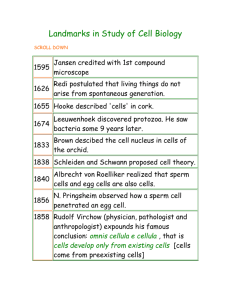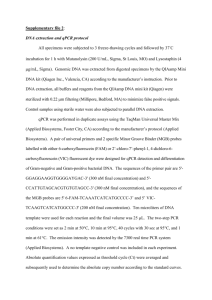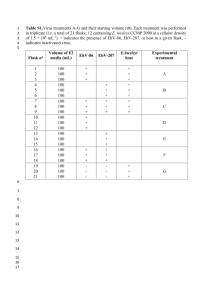DNA extraction
advertisement
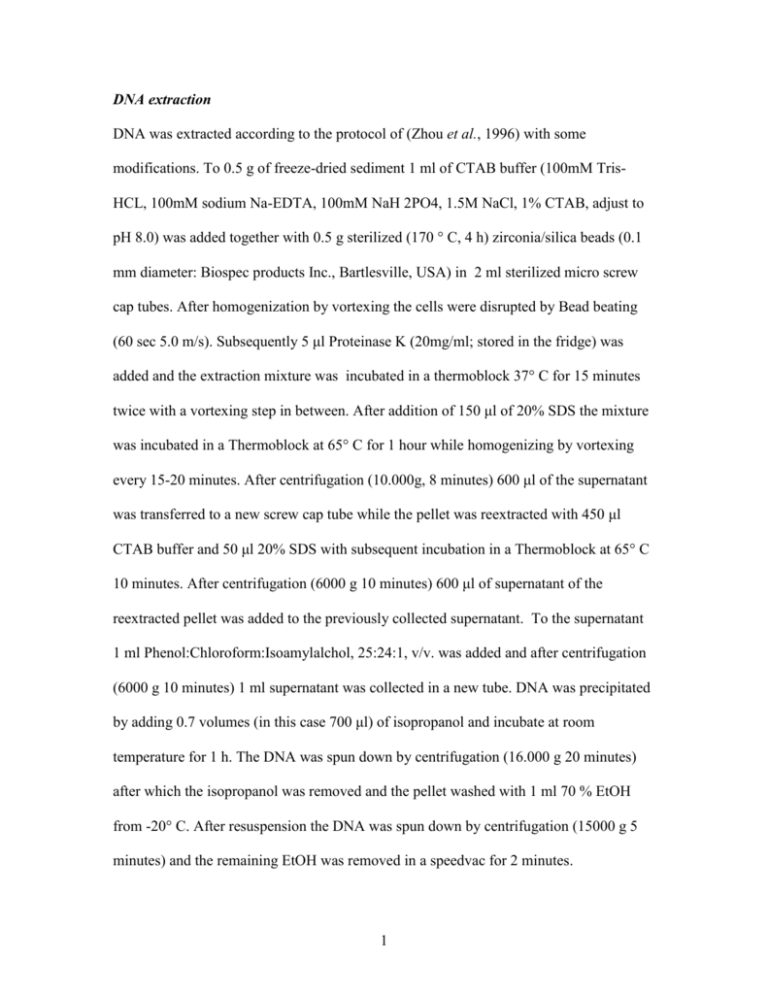
DNA extraction DNA was extracted according to the protocol of (Zhou et al., 1996) with some modifications. To 0.5 g of freeze-dried sediment 1 ml of CTAB buffer (100mM TrisHCL, 100mM sodium Na-EDTA, 100mM NaH 2PO4, 1.5M NaCl, 1% CTAB, adjust to pH 8.0) was added together with 0.5 g sterilized (170 ° C, 4 h) zirconia/silica beads (0.1 mm diameter: Biospec products Inc., Bartlesville, USA) in 2 ml sterilized micro screw cap tubes. After homogenization by vortexing the cells were disrupted by Bead beating (60 sec 5.0 m/s). Subsequently 5 μl Proteinase K (20mg/ml; stored in the fridge) was added and the extraction mixture was incubated in a thermoblock 37° C for 15 minutes twice with a vortexing step in between. After addition of 150 μl of 20% SDS the mixture was incubated in a Thermoblock at 65° C for 1 hour while homogenizing by vortexing every 15-20 minutes. After centrifugation (10.000g, 8 minutes) 600 μl of the supernatant was transferred to a new screw cap tube while the pellet was reextracted with 450 μl CTAB buffer and 50 μl 20% SDS with subsequent incubation in a Thermoblock at 65° C 10 minutes. After centrifugation (6000 g 10 minutes) 600 μl of supernatant of the reextracted pellet was added to the previously collected supernatant. To the supernatant 1 ml Phenol:Chloroform:Isoamylalchol, 25:24:1, v/v. was added and after centrifugation (6000 g 10 minutes) 1 ml supernatant was collected in a new tube. DNA was precipitated by adding 0.7 volumes (in this case 700 μl) of isopropanol and incubate at room temperature for 1 h. The DNA was spun down by centrifugation (16.000 g 20 minutes) after which the isopropanol was removed and the pellet washed with 1 ml 70 % EtOH from -20° C. After resuspension the DNA was spun down by centrifugation (15000 g 5 minutes) and the remaining EtOH was removed in a speedvac for 2 minutes. 1 Subsequently the DNA was resuspended in 50-100 μl sterilized water and stored at -20 C. QPCR analyses The following samples were used for QPCR analyses: 2.3(0-3cm), 8.2(0-3cm) and 8.3(03cm). The DNA content of the purified samples was measured using the NanoDropR ND1000 (Nano-Drop Technologies, Wilmington, DE, USA) and samples were diluted accurately to obtain concentrations of 10 ng/μl. The WCGA solution of all samples was diluted 100 times which appeared to be sufficient to avoid PCR inhibition. Every sample was analysed in triplicate. Type Ia and type II methanotrophic sub-groups were quantified using the assays described by (Kolb et al., 2003) with modifications concerning primer concentrations and fluorescence recording temperature. The QPCR was performed with a Rotor Gene 6000 thermal cycling system (Corbett Research, Sydney, Australia), in which samples and standards were added to aliquots of the master mixture using a CAS-1200 (Corbett Robotics) liquid handling system. Each 25 µl reaction containing 2.5 µl of sample DNA in combination with ABSolute QPCR SYBR green mix (ABgene, Epsom, UK) and primers in optimized concentrations was performed in triplicate. For type Ia specific Q-PCR, the thermal cycle consisted of an initial denaturation at 95°C for 15 min, followed by 45 cycles of denaturation at 94°C for 25 s, annealing at 54°C for 20 s, and extension at 72°C for 45 s. For the type II specific Q-PCR, the thermal cycle consisted of an initial denaturation at 95°C for 15 min, followed by 45 cycles of denaturation at 94°C for 20 s, annealing at 60°C for 20 s, and extension at 72°C for 45 s. Data were acquired at 82 °C for type Ia and 85 °C for type II. 2 Reaction products were verified by DNA melting curve analysis at temperatures ranging from 75°C to 95°C. Reaction products were also verified by 1.0% (wt/vol) agarose gel electrophoresis (data not shown). Only data from Q-PCR reactions of which a product of the expected size was visible on agarose gel were used for further analysis. Amplification efficiencies of the Q-PCR reaction did not differ significantly. For the type Ia assay, calibration curves were prepared by dilution of a known amount of PCR product previously amplified from a pmoA harbouring plasmid (clone C13, product length 608 bp) by using the M13f –M13r primer set. For the type II specific assay, calibration curves were prepared by dilution of a known amount of PCR product the pmoA harbouring plasmid (clone AD62), product length 616 bp). 3
